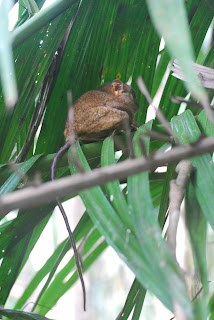When I found out I was coming to Bohol and started researching the island, the first thing that jumped out at me (and made me squeal a bit, suprise, suprise) was the image of tarsiers! Last Friday, I had my chance to see one. As a way to lift our spirits after having to cancel our whale shark survey, we headed to the Tarsier Foundation in Corella in the interior of the province. Here is the proof:
Crazy looking, eh? So what’s a tarsier, you ask? Well, let me tell you...
A tarsier is a small primate that belongs to the suborder Prosimii. There are four species of tarsiers classified: the Bornean tarsier (Tarsius bancanus) of Borneo and Sumatra, the Spectral tarsier (Tarsius spectrum) and another dwarf species (Tarsius pumilis) of Sulawesi, and the Philippine tarsier (Tarsius syrichta). In the Philippines, Bohol is one of the few islands that hosts this wee creature. It’s one of the smallest species of primates in the world (they will try to tell you that it’s the smallest, but it’s not true). On average, they weigh only 120 grams, and are no more than 100 millimeters tall. Their tails are super long compared to their body size and prehensile (warning Megan: It looks like a rat tail).
Most striking are their eyes! A tarsiers’ orbital (eye socket) to skull ratio is 150% greater than that of humans!
Interestingly, they cannot see from the corners of their eyes, but their head is able to rotate 180°. As you’ve probably guessed, they are nocturnal animals. We saw them during the day when they were inactive, clinging to a tree to rest. They are able to hold on vertically as a result of the adhesive discs on the soles of their fore and hind limbs. Plus, they have awesom E.T. fingers!
Unfortunately, the Philippine tarsier population is in trouble and now listed and ‘Near Threatened’ and declining by the IUCN. Tarsiers have a list of threats including the introduction of domestic cats, habitat destruction, hunting and collection for the pet and tourist trade. There is now a large campaign in Bohol by the Tarsier Foundation trying to educate tourists not to support tarsier capture. Many are collected from the wild and used for handling and photo opportunities for tourists. They do very poorly in captivity and die quickly, causing more capture. This person is an idiot (as are the many others in pictures I found searching 'tarsier' on google) :
The tarsiers we saw live in an enclosed reserve, which is part of a much larger area (134 ha) protected and managed by the Tarsier Foundation, a local NGO. They have guides that take you into the semi enclosed area to see the few animals living in there (we saw three of the ten). You aren’t able to get too close or use your flash, as they are easily disturbed (all the pics above were taken with a 300mm lens) . They also have an educational centre and do research and advocacy to help protect further tarsier habitat. Learn more about them and tarsiers here: www.tarsierfoundation.org





While I read this I heard your "professional voice" in my head. Good nature talk.
ReplyDeleteI learned a lot, like how domestic cats are the source of all problems.
I love their eyes, but eeww those tails! I agree with Erin, this was definitely a good nature talk . . . not sure how many travel blogs feature the word "prehensile" (gave myself a pat on the back for knowing what it meant, though I Googled just to be sure!) Glad you got a chance to visit the reserve.
ReplyDeleteAwesome! Bring one home so he can point his ET finger at Elliot.
ReplyDelete